Producer Of The Year: The Talented Aurélien Laherte ‘Quest For The Perfect Alchemy’
Sparklers To Ring In The New Year
This week (like many of you) we mark the arrival of a new year with the wine style most associated with celebration: Effervescent. At Elie’s, this bubbly occasion is the culmination of a year spent like a cat with a laser pointer as we chase down the best sparkling wines of France and Spain, ending up in familiar appellations in Champagne and some finding off-the-beaten path gems in terroirs where Méthode Champenoise may not be the first words that come to mind. In Alsace, for example, Domaine Valentin Zusslin produces a textbook-perfect Crémant using pure Bollenberg Pinot Noir, while Domaine Michel Briday’s sparkling Burgundy hails from 38 acres spread across the municipalities of Rully, Bouzeron and Mercurey. In Spain, amid the unblemished beauty of the Penedès, Pepe Raventós brainchild winery Can Sumoi has captured the smells and flavors of Catalunya in his remarkable portfolio of pétillant and sparkling.
With season of sparkles fully upon us, we will cap the year in our usual fashion—by showcasing the wines of a particularly interesting producer. This year, the talented Aurélien Laherte from Champagne Laherte Frères gets the nod, offering us an array of Coteaux Sud d’Epernay gems that have raised the quality bar in this somewhat lesser-known of Champagne’s 7 ‘regions’, the spiritual home of Meunier. Aurélien also experiments with some of Champagne’s nearly forgotten varietals and is lauded for his attention to lieu-dit expression as well as his mastery of the fine art of blending.
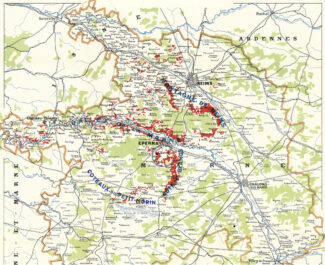
Champagne Laherte Frères
Champagne’s Coteaux Sud d’Epernay
Terroir Fundamentals: Preserving Its Details
When trying to demystify the mysterious—and to ground the ethereal—words like ‘alchemy’ (the ancient pseudoscience of spinning gold from base metals) may seem problematic. And yet, under the nimble hands of Aurélien Laherte, the full range of Champagne’s ‘next-level’ magic takes center stage.
‘Next-level’ because Laherte is one of the most progressive young winemakers in the Coteaux Sud d’Epernay, a sub-region sandwiched between the Côtes des Blancs and the Vallée de la Marne. A champion of organics and biodynamics, Aurélien produces a lineup of blended and single-vineyard Champagnes that expresses the unique identities of his terroirs.
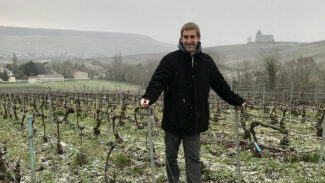
Aurélien Laherte, Champagne Laherte Frères
The quest for perfection is a keystone in the plans of every winemaker, but in Champagne, where warming temperatures are created consistently better harvests and a return to a natural approach is making terroir more and more transparent; the luck of the draw is shifting to the skills of the Cellar Master. Knowing when to blend and when to let an individual lieu-dit shine through is among the most valuable tools in the chest, and when deployed correctly, allows the vintner to create wines worth their weight in gold.
The result is clear, chiseled Champagnes that are created with the sole intention of reflecting the nuances of the plot in which they originate. The estate, with 75 parcels situated in three distinct areas (the southern slopes of Épernay, the Côte des Blancs, and the Marne Valley) is centered in the village of Chavot in the Côteaux Sud d’Epernay. They produce around 150,000 bottles a year, and this week’s offering contains a cross-section of the most outstanding.
Single Variety
Champagne’s Nod To Burgundy
Bordeaux, and indeed much of Champagne, blends grape varieties to create signature ‘house’ wines. In Burgundy, the thinking is different: Burgundies are primarily monocépages, meaning they are made from a single grape variety, often sourced from a single vineyard. In Bordeaux, the monocépage concept is virtually unknown, but in Champagne, most prominent producers will offer at least one or two in their portfolio, Blanc de Noirs or Blanc de Blancs. Frequently they are vintage cuvée produced only in years where a special set of conditions are met and only released in limited quantities.
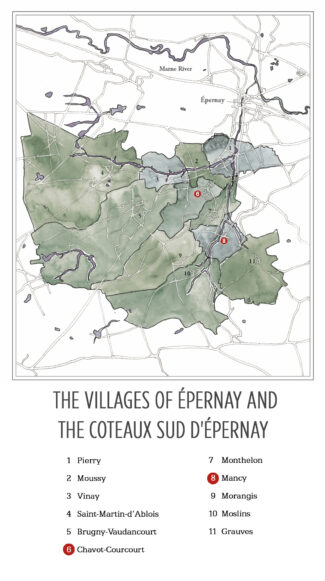
• Blanc de Blancs
Blanc de Blancs—a term found only in Champagne—is used to refer to Champagne produced entirely from white grapes, most commonly Chardonnay. Pinot Blanc and Petit Meslier can also be used, as well as a number of other varieties permitted in the appellation, but these are much less common.
Chardonnay: ‘Emblematic Cuvée’
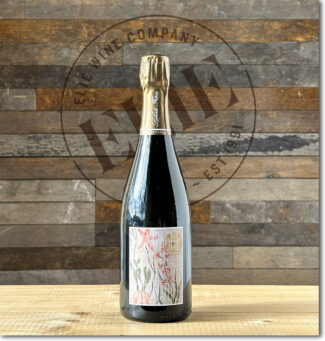 Champagne Laherte Frères, Coteaux-Sud-d’Epernay Blanc de Blancs Brut Nature ($59)
Champagne Laherte Frères, Coteaux-Sud-d’Epernay Blanc de Blancs Brut Nature ($59)
100% Chardonnay from the south-facing slopes of Épernay and Chavot, grown on soft clay and chalk and harvested from vines about 35 years old. The wine is fermented in small foudres and barrels with minimal bâtonnage; it undergoes partial (20%) malolactic and is aged on fine lees prior to disgorgement. The zero dosage is balanced by the creaminess of the malo; the wine shows bright tropical fruit flavors, especially mango with a hint of ginger. Disgorged January 2023.
Chardonnay: ‘White with A View’
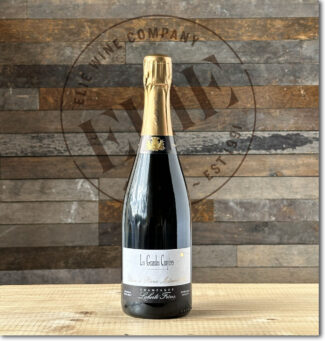 Champagne Laherte Frères, 2019 Coteaux-Sud-d’Epernay Chavot ‘Les Grandes Crayères’ Blanc de Blancs Extra-Brut ($91)
Champagne Laherte Frères, 2019 Coteaux-Sud-d’Epernay Chavot ‘Les Grandes Crayères’ Blanc de Blancs Extra-Brut ($91)
100% Chardonnay from Chavot mid-slopes where soft Campanian chalk gives these old vines a perfect substratum on their western exposition. This is a single-vineyard cuvée with vines grown using sélections massales and a blend of new and old rootstocks. Disgorgement is done by hand, with dosage at 3 gram/liter. A classic Coteaux Sud Blanc de Blancs showing notes of crème brûlée, apple pie, Jerez-like nuttiness and an extremely fine mousse. Disgorged November 2022. 3928 bottles produced.
Petit Meslier: ‘Vibrant and Expressive’
Petit Meslier is a nearly-forgotten grape of which Laherte is so enamored that he replanted a portion of the clay and silt (with chalk below) mid-slope in the hills of Chavot to preserve the varietal diversity of Champagne. Don’t confuse Meslier with the similar-sounding Meunier; it is a white grape made by crossing Gouais Blanc with Savagnin. Currently grown in small quantities in Champagne, it is noted for its heat resistance and ability to maintain acids during long spells of hot weather and, when vinified as a monocépage, provides tremendous aromatic intensity and depth.
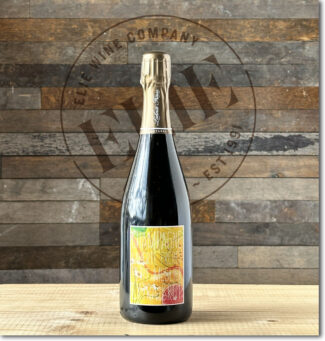 Champagne Laherte Frères ‘Petit Meslier’, Coteaux-Sud-d’Epernay Extra-Brut ($130)
Champagne Laherte Frères ‘Petit Meslier’, Coteaux-Sud-d’Epernay Extra-Brut ($130)
100% Petit Meslier. In creating his iconic, all-inclusive blend ‘Les 7’, Aurélien was particularly struck by the ability of his Petit Meslier to stand on its own. From a vineyard called ‘Cépage Oubliés’, it is a blend of several harvests with 40% reserve wine and aged for six months on its lees ‘fût de chêne’, or in oak barrels; it shows honeyed pear, buttered toast and toasted almonds behind an unsurprisingly racy spine of acidity. Disgorged September 2022.
• Blanc de Noirs
In Champagne, Blanc de Noirs mean that the wine is made from either Pinot Noir or Meunier (or a blend of the two), although it’s relatively common to find 100% Pinot Noir. Despite the ‘Noir’, they may be notably ‘Blanc’ since both Pinot Noir and Meunier are red skinned, white-fleshed grapes that produce clear juice. Without being given time to macerate on the dark skins, the wine will be white to the eye, though much more to the palate.
Meunier: ‘Celebrating the Variety’
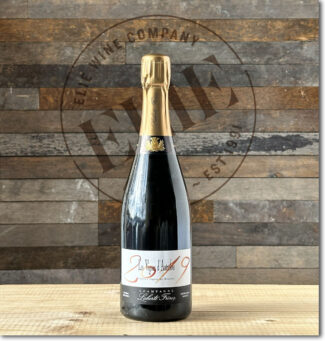 Champagne Laherte Frères ‘Les Vignes d’Auterfois – Vieilles Vignes de Meunier’, 2019 Coteaux-Sud-d’Epernay Extra-Brut ($91)
Champagne Laherte Frères ‘Les Vignes d’Auterfois – Vieilles Vignes de Meunier’, 2019 Coteaux-Sud-d’Epernay Extra-Brut ($91)
The selected Meunier plots for this wine were planted by the Laherte family between 1947 and 1953 in the villages of Chavot (lieux-dits La Potote and Les Rouges Maisons) and Mancy (lieu-dit Les Hautes Norgeailles). Some of the vines were planted on French rootstock while others are the result of old sélection massale. Aurélien uses traditional wooden Coquard presses; fermentation occurs with native yeast in old Burgundy barrels and malolactic fermentation does not take place. The wine ages up to 19 months on the lees and dosage is between two and four grams per liter; it exhibits marvelous aromas of white peach, violets and verbena. Disgorged November 2022. 4396 bottles produced.
Pinot Noir: ‘Deep and Faithful’
Pinot Noir accounts for 38% of the area under vine in Champagne and is the dominant grape in Montagne de Reims and Côte des Bar. It is frequently referred to as ‘Précoce’ due to its tendency to ripen early, leaving behind the acidity so prized by Champagne makers. It thrives in cool, chalky soil—a hallmark of Champagne’s terroir.
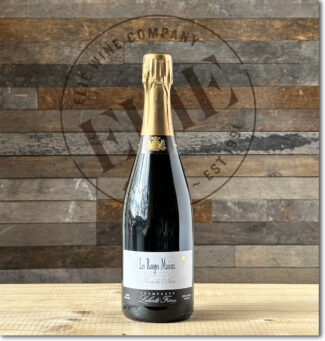 Champagne Laherte Frères, Coteaux-Sud-d’Epernay Chavot ‘Les Rouges Maisons’ Blanc de Noirs Extra-Brut ($91)
Champagne Laherte Frères, Coteaux-Sud-d’Epernay Chavot ‘Les Rouges Maisons’ Blanc de Noirs Extra-Brut ($91)
100% Pinot Noir (harvest 2019) from the prized lieu-dit Les Rouges Maisons planted in 1983 on rich soils of silex, schist and limestone. Malolactic is employed and dosage a scant 2 grams per liter to produce a rich BdN, poised on the palate and showing the austerity, finesse and racy freshness typical of this terroir. Disagorged November 2022. 1698 bottles produced.
Pinot Noir: ‘Intense and Straight’
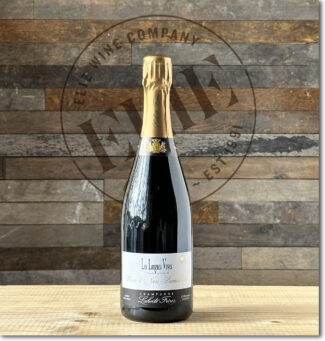 Champagne Laherte Frères, 2019 Montagne-de-Reims Premier Cru Chamery ‘Les Longue Voyes’ Blanc de Noirs Extra-Brut ($91)
Champagne Laherte Frères, 2019 Montagne-de-Reims Premier Cru Chamery ‘Les Longue Voyes’ Blanc de Noirs Extra-Brut ($91)
Part of Aurélien Laherte’s’ ‘Terroirs’ series, this is the second incarnation of ‘Les Longue Voyes’, a Blanc de Noirs Champagne made entirely from Pinot Noir. The fruit comes from the village of Chamery on the Petite Montagne de Reims, nearly twenty miles from the estate—hence the name, which means ‘The Long Way’. Barrel aged for 18 months with a 4 grams per liter dosage and no malolactic, the nose reveals notes of black fruits, and the palate is tense, tasty and tonic with a persistent saline finish. Disgorged November 2022. 3274 bottles produced.
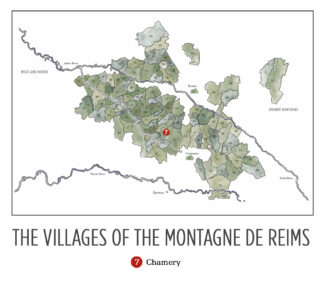
• Rosé
Credit Madame Clicquot for revolutionizing the (then) relatively small production of pink Champagne. A believer in the idea that a wine should flatter both the eye and the palate, the Grande Dame broke with tradition and re-created the process of making rosé champagne. Before, it was made by adding an elderberry-based mixture to white Champagne, but Madame Clicquot had vines in the Bouzy region of Champagne where she made her own red wine, and she decided to blend this with her still white wines.
This is the most common method of producing rosé Champagne—blending clear white and black grape musts, using between 5% and 15% red wine; it is called a rosé of ‘assembly’. The proportion of red wine can vary, but the white wine must be the majority. Another method of rosé production is the ‘saignée’ method, which involves allowing the must to undergo minimal skin contact, generally for only a couple of hours. This minimal maceration allows the must to develop stronger aromas and flavor profiles while deepening the color. ‘Saignée’ translates literally to ‘bleeding’, which is essentially what the skins are doing into the juice.
Meunier: ‘Strong Identity’
Traditionally used as a blending grape, there are about 26,000 acres of Meunier planted in Champagne, and the variety is rapidly becoming more than an afterthought used for color and balance. In the right soil conditions (calcareous clay with deeper chalk layers) and if allowed to ripen well (leapfrogging the vegetal stage) it can produce a wine that ages remarkably, showing finesse and freshness even after years in the bottle.
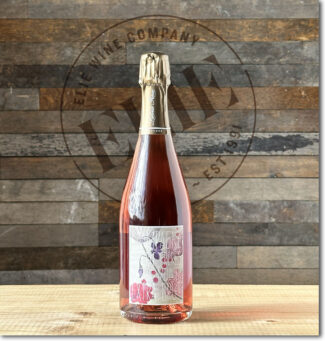 Champagne Laherte Frères ‘Rosé de Meunier’, Extra-Brut Rosé ($61)
Champagne Laherte Frères ‘Rosé de Meunier’, Extra-Brut Rosé ($61)
100% Meunier, the wine is sourced from vineyards in the Vallée de la Marne and Chavot with an average age of 25 years for the Meunier vinified white and more than 40 years for the parcels selected for the red wine. It is a blend of 30% macerated Meunier, 60% white wine from Meunier and 10% still red Meunier. As a result, it uses both methods of Champagne rosé creation, assemblage (blending) and saignée (bleeding). The wine is multi-layered with a ripe core of red fruit and brisk girdling acids. Disgorged March 2023.
Meunier: ‘Varietal Complexity and Nuances’
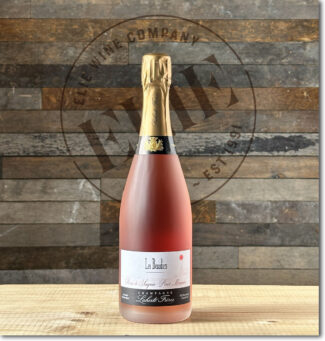 Champagne Laherte Frères, Coteaux-Sud-d’Epernay Chavot ‘Les Beaudiers’ Extra-Brut Rosé de Saignée ($91)
Champagne Laherte Frères, Coteaux-Sud-d’Epernay Chavot ‘Les Beaudiers’ Extra-Brut Rosé de Saignée ($91)
Produced entirely from Meunier (harvest 2019) which comes from plots situated in ‘Les Beaudiers’ in Chavot and cultivated using methods which include short pruning for a limited production; manual and painstaking work that requires regular plowing. The grapes were destemmed and macerated for twelve hours, then fermented in barrels on natural yeast without malolactic. The wine shows layers of pomegranate, wild strawberry and rose petals above an exquisite bead and all the depth and density one expects in a saignée. Disgorged November 2022. 1672 bottles produced.
Blending
A Tapestry Of Few Threads
Champagne should illustrate the word ‘synergy’ above all, where the sum of the total is greater than the individual parts. The ideal blend should be the aggregation of positive components; every thread should add to the tapestry’s whole. The blend should always drive toward harmony; Chardonnay is often up front, while Pinot Noir supplies the middle and finish. Other allowable varietals should only appear if they contribute to the primary blend.
This is not a universal outcome, of course, and according to Jean-Marc Lallier of Champagne Deutz, “Some winemakers do not blend; they mix.”
When cellar masters do it right, it is a painstaking undertaking; every tank, barrel and vat is tasted countless times to assess which batch would enhance which. This is the true art of Champagne making—the intimate familiarity with each component in order to align them perfectly.
At Laherte, Aurélien does not have a recipe for a single wine; he blends according to the call from the barrel and each blend has a trademark distinction. He prefers very low dosage, insisting that the wine’s minerality must speak first. Regarding the tedious art of blending, he says, “They’re like people; one needs to be strong, one of them weak; one bitter, one elegant.”
Highlighting Village Chavot’s Terroir: Diversity Of Soil
The commune of Chavot-Courcourt consists of Chavot (in the northeastern part of the commune) and Courcourt (in the central part of the commune), but also the small villages Ferme du Jard, Les Fleuries, La Grange au Bois, and Le Pont de Bois. Among the many folds and hills in the area, the upper reaches are clay-dominant while the soils turn chalkier as you descend. Most of the vineyards in Chavot-Courcourt are located in the northern part of the commune, on slopes formed by the stream Le Cubry.
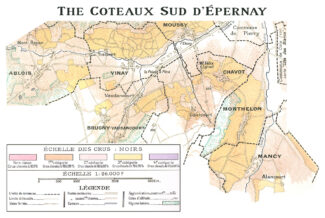
Aurélien Laherte explains why he farms so many individual parcels in a relatively small area: “Below the village especially is a significant difference in soil types. I have identified 27 terroir-types in Chavot-Courcourt alone and farm 45 parcels. There is no sand, but there is virtually everything else—from chalk to clay to limestone. Between them are countless fine-grained distinctions, so I treat them individually and vinify them separately.”
Les Beaudiers is a vineyard in Chavot where Laherte Frères has old vines of Pinot Meunier (planted in 1953, 1958, and 1965) that are used for a rosé saignée. Other vineyard sites in Chavot-Courcourt include Les Charmées, Les Chemins d’Epernay, Les Monts Bougies, Les Noelles, La Potote, and Les Rouges Maison, all used by Laherte Frères for their Champagnes Les Vignes d’Autrefois and Les Empreintes.
Although Meunier is the dominant grape variety, Laherte also owns a vineyard called ‘Les Clos’ where he plants all seven legally allowable Champagne grape varieties. From this he concocts the individual-vinification philosophy by picking and pressing all seven varietals together.
‘Duality of Terroir’
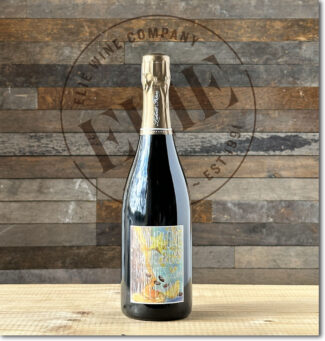 Champagne Laherte Frères ‘Les Empreintes’, 2017 Coteaux-Sud-d’Epernay Chavot Extra-Brut ($99)
Champagne Laherte Frères ‘Les Empreintes’, 2017 Coteaux-Sud-d’Epernay Chavot Extra-Brut ($99)
From two parcels in the Chavot lieux-dits Les Chemins d’Épernay and Les Rouges Maisons, each (in Aurélien’s words) ‘exemplifying the quintessence of the Chavot terroir.’ The wine is a classic Champagne blend, half Chardonnay, (of which one-third is Chardonnay Muscaté) from Les Chemins d’Epernay where there are clay soils with a little silt stratum in surface and a chalky subsoil—vine planted in 1957. The other half is Pinot Noir from Les Rouges Maison where the soil is fairly deep with a vital presence of clay, flints and schists; these vines were planted in 1983. With a dosage of 3.5 grams per liter, it is a resonant Champagne with floral top notes and deftly balanced acidity. Disgorged October 2022.
‘Infusion’
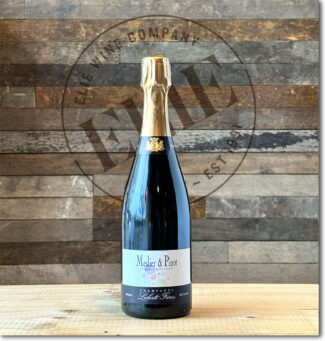 Champagne Laherte Frères ‘Infusion – Meslier & Pinot’, Coteaux-Sud-d’Epernay Chavot Brut Nature ($150)
Champagne Laherte Frères ‘Infusion – Meslier & Pinot’, Coteaux-Sud-d’Epernay Chavot Brut Nature ($150)
Only 600 bottles were made of this tiny cuvée. The blend is 50% Petit Meslier and 50% Pinot Noir from two plots in Chavot, and it spends 30 months on the lees in barrel before being bottled without dosage. True to its name, the crisp fruit of Meslier is infused with Pinot Noir’s vinosity, and the wine shows green apple, citrus peel, almond and stone flavors that linger through a long, nicely balanced finish. Disgorged October 2022. 669 bottles produced.
‘Tribute to Yesterday’s Wines’
The soléra system of maturation used for Sherry, the famous fortified wine of Jerez, is a cry for consistency from vintage to vintage. The system involves removing wine for release from the last of a series of barrels that contains a blend of every vintage since the soléra was started. The void in those barrels is then filled with wine from another series of barrels, and so on, until there is room in the youngest series of barrels. The wine from the most recent vintage is added to those barrels.
In Champagne, the method used is slightly different; after each harvest, wine is added to the blend, and every time a producer is ready to release a new batch of non-vintage Champagne, he removes what he needs. Over time, the cuvée becomes increasingly complex as the fresh wines of the latest vintage taking on the mature qualities of those that came before it. It is a system used by surprisingly few producers in Champagne, but Laherte Frères is one of them.
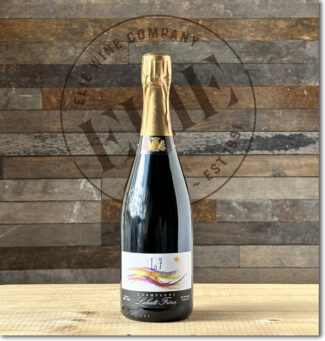 Champagne Laherte Frères ‘Les 7 Soléra’, Coteaux-Sud-d’Epernay Chavot Extra-Brut ($130)
Champagne Laherte Frères ‘Les 7 Soléra’, Coteaux-Sud-d’Epernay Chavot Extra-Brut ($130)
As the name suggests, all seven allowable Champagne grapes are used in this single cuvée; 10% Fromenteau, 8% Arbane, 14% Pinot Noir, 18% Chardonnay, 17% Pinot Blanc, 18% Meunier and 15% Petit Meslier from a vineyard planted by Thierry Laherte in 2003. He picks and presses all seven together and employs his perpetual cuvée: Les 7 contains wine not only from the current vintage, but draws bits of reserve wine from all harvests dating back to 2005, the year Aurélien took over the domain. All bottles are disgorged by hand with a dosage of 4 grams per liter. The wine shows lemon zest, crystalline green-apple candy and floral notes in a stony infrastructure. Disgorged November 2021. 3621 bottles produced.
‘Return to Basics’
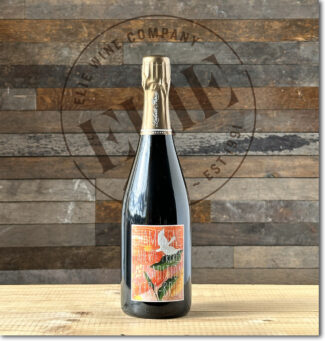 Champagne Laherte Frères ‘Ultradition’, Extra-Brut ($54)
Champagne Laherte Frères ‘Ultradition’, Extra-Brut ($54)
60% Meunier, 30% Chardonnay and 10% Pinot Noir from vineyard plots in the Côteaux Sud d’Epernay, Vallée de la Marne and Côte des Blancs where vines average around 30 years. The wine ages in barrels for six months and given light filtration before bottling during the spring time; 6-8 gr/l dosage. The wine offers a complex bouquet of dried apple and toasted walnut; the Meunier lends floral tones and an upper-register smokiness. Disgorged September 2022.
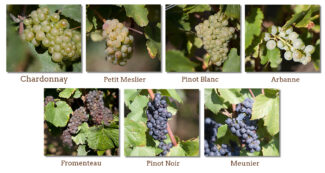
Coteaux-Champenois: Still Champagne
Is It Still Champagne?
The Coteaux-Champenois AOP is dedicated entirely to non-effervescent wine from Champagne and may be red, white or rosé, although the lion’s share is red—Bouzy rouge being the most celebrated. With a warming climate ripening grapes more consistently, Coteaux-Champenois is becoming positively trendy and producers across the 319 communes entitled to make wines under the Coteaux Champenois appellation.
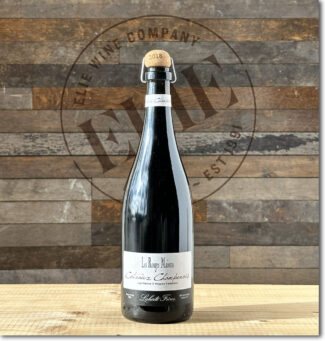 Domaine Laherte Frères, 2018 Coteaux-Champenois ‘Les Rouges Maisons’ Rouge ($73)
Domaine Laherte Frères, 2018 Coteaux-Champenois ‘Les Rouges Maisons’ Rouge ($73)
100% Pinot Noir from the prized Les Rouges Maisons lieu-dit; Aurélien says. “At the domain, we love diversity and we have a naturally curious and imaginative winegrower spirit! After a few years, we are happy to be able to present some Coteaux Champenois to you again. In 2018, the harvest was beautiful, generous, with maturities rarely reached and with a full and intense aroma. It seemed obvious to us to push the maturities on a few plots, in order to seek phenolic maturity and an interesting structure to develop Coteaux-Champenois.”
The wine shows off the chalky terroir in a mineral-driven Pinot Noir filled with the finesse and tension that reflects true Champagne character. Only 854 bottles were made.
Notebook
The Coteaux Sud d’Épernay: Middle Grounds, Between Two Giants
The Coteaux Sud d’Épernay is Meunier-rich, with 47% of its 3000 acres planted to this variety, which is sometimes imagined as an ‘also ran’ in Champagne. In fact, Meunier is suited for soils that contain more clay and in terroirs with harsher climatic conditions since it buds late and makes it more resistant to frost. Sandwiched between the powerhouse wine regions Côte des Blancs and Vallée de la Marne, the Coteaux has an identity removed from either one; its terroir is distinctly different from the clay-heavy soils of the Marne and lacks the chalk of that puts the ‘blanc’ in the Côte des Blancs.
Phrasing it succinctly is Laherte Frères proprietor Aurélien Laherte: “Our wines show more clay influence than those of the Côte des Blancs and they are chalkier than the wines of the Vallée de la Marne.”
In short, these Champagnes are uniquely situated to offer the best of both worlds. As a result, the Coteaux Sud d’Épernay has long fought for recognition as entity unto itself, not necessarily a sub-region of its big brothers on either side.
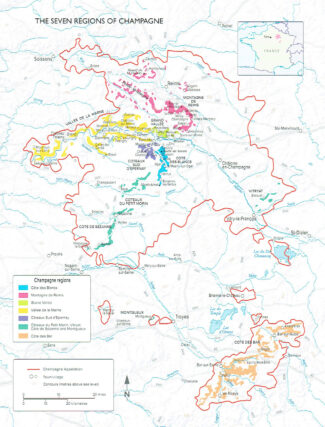
Drawing The Boundaries of The Champagne Region
Having been defined and delimited by laws passed in 1927, the geography of Champagne is easily explained in a paragraph, but it takes a lifetime to understand it.
Ninety-three miles east of Paris, Champagne’s production zone spreads across 319 villages and encompasses roughly 85,000 acres. 17 of those villages have a legal entitlement to Grand Cru ranking, while 42 may label their bottles ‘Premier Cru.’ Four main growing areas (Montagne de Reims, Vallée de la Marne, the Côte des Blancs and the Côte des Bar) encompass nearly 280,000 individual plots of vines, each measuring a little over one thousand square feet.
The lauded wine writer Peter Liem expands the number of sub-regions from four to seven, dividing the Vallée de la Marne into the Grand Vallée and the Vallée de la Marne; adding the Coteaux Sud d’Épernay and combining the disparate zones between the heart of Champagne and Côte de Bar into a single sub-zone.
Lying beyond even Liem’s overview is a permutation of particulars; there are nearly as many micro-terroirs in Champagne as there are vineyard plots. Climate, subsoil and elevation are immutable; the talent, philosophies and techniques of the growers and producers are not. Ideally, every plot is worked according to its individual profile to establish a stamp of origin, creating unique wines that compliment or contrast when final cuvées are created.
Champagne is predominantly made up of relatively flat countryside where cereal grain is the agricultural mainstay. Gently undulating hills are higher and more pronounced in the north, near the Ardennes, and in the south, an area known as the Plateau de Langres, and the most renowned vineyards lie on the chalky hills to the southwest of Reims and around the town of Épernay. Moderately steep terrain creates ideal vineyard sites by combining the superb drainage characteristic of chalky soils with excellent sun exposure, especially on south and east facing slopes.
- - -
Posted on 2023.12.30 in Coteaux Champenois, France, Champagne, Wine-Aid Packages
Featured Wines
- Notebook: A’Boudt Town
- Saturday Sips Wines
- Saturday Sips Review Club
- The Champagne Society
- Wine-Aid Packages
Wine Regions
Grape Varieties
Aglianico, Albarino, Albarín Tinto, Albillo, Aleatico, Alicante Bouschet, Aligote, Altesse, Aubun, Auxerrois, Barbarossa, Beaune, Biancu Gentile, Bonarda, bourboulenc, Cabernet Franc, Cabernet Sauvignon, Caino, Caladoc, Carignan, Chablis, Chardonnay, Chenin Blanc, Cinsault, Clairette, Cortese, Corvina, Corvinone, Cot, Counoise, Dolcetto, Fiano, Frappato, Friulano, Fumin, Gamay, Garganega, Garnacha Tintorera, Godello, Graciano, Grenache, Grenache Blanc, Grolleau, Groppello, Jacquère, Lladoner Pelut, Maconnais, Malbec, Malvasia, Malvasia Nera, Marcelan, Marselan, Marzemino, Melon de Bourgogne, Mencía, Merlot, Mondeuse, Montepulciano, Montònega, Morescola, Mourv, Mourvèdre, Muscadelle, Muscat, Natural, Nebbiolo, Nero d'Avola, Niellucciu, Patrimonio, Pecorino, Pedro Ximénez, Persan, Petit Verdot, Pineau d'Aunis, Pinot Auxerrois, Pouilly Fuisse, Pouilly Loche, Poulsard, Prieto Picudo, Riesling, Rondinella, Rousanne, Roussanne, Sagrantino, Sangiovese, Savignin, Sciacarellu, Souson, Sylvaner, Syrah, Tannat, Tempranillo, Teroldego, Timorasso, Treixadura, Trousseau, vaccarèse, Viognier, Viura, Xarel-loWines & Events by Date
- May 2024
- April 2024
- March 2024
- February 2024
- January 2024
- December 2023
- November 2023
- October 2023
- September 2023
- August 2023
- July 2023
- June 2023
- May 2023
- April 2023
- March 2023
- February 2023
- January 2023
- December 2022
- November 2022
- October 2022
- September 2022
- August 2022
- July 2022
- June 2022
- May 2022
- April 2022
- March 2022
- February 2022
- January 2022
- December 2021
- November 2021
- October 2021
- September 2021
- August 2021
- July 2021
- June 2021
- May 2021
- April 2021
- March 2021
- February 2021
- January 2021
- December 2020
- November 2020
- October 2020
- September 2020
- August 2020
- July 2020
- June 2020
- May 2020
- April 2020
- March 2020
- February 2020
- January 2020
- December 2019
- November 2019
- October 2019
- September 2019
- August 2019
- July 2019
- June 2019
- May 2019
- April 2019
- March 2019
- February 2019
- January 2019
- December 2018
- November 2018
- October 2018
- September 2018
- August 2018
- July 2018
- June 2018
- May 2018
- April 2018
- March 2018
- February 2018
- January 2018
- December 2017
- November 2017
- October 2017
- September 2017
- August 2017
- July 2017
- June 2017
- May 2017
- April 2017
- March 2017
- February 2017
- January 2017
- December 2016
- November 2016
- October 2016
- September 2016
- August 2016
- July 2016
- June 2016
- May 2016
- April 2016
- March 2016
- February 2016
- January 2016
- December 2015
- November 2015
- October 2015
- September 2015
- August 2015
- July 2015
- June 2015
- May 2015
- April 2015
- March 2015
- February 2015
- January 2015
- December 2014
- November 2014
- October 2014
- September 2014
- August 2014
- July 2014
- June 2014
- April 2014
- March 2014
- February 2014
- January 2014
- December 2013
- November 2013
- October 2013
- September 2013
- August 2013
- July 2013
- June 2013
- May 2013
- April 2013
- March 2013
- February 2013
- January 2013
- December 2012
- November 2012
- October 2012
- February 2004
Search



